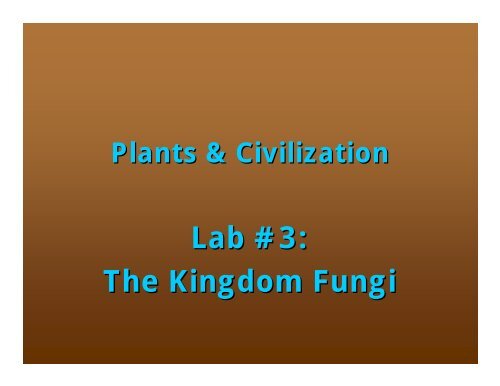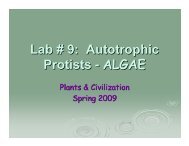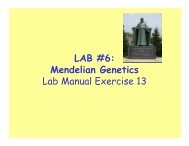Lab #3: The Kingdom Fungi
Lab #3: The Kingdom Fungi
Lab #3: The Kingdom Fungi
Create successful ePaper yourself
Turn your PDF publications into a flip-book with our unique Google optimized e-Paper software.
Plants & Civilization<br />
<strong>Lab</strong> <strong>#3</strong>:<br />
<strong>The</strong> <strong>Kingdom</strong> <strong>Fungi</strong>
<strong>Fungi</strong>: An Overview<br />
Diverse group of organisms<br />
Unicellular (yeasts)<br />
Multicellular<br />
Heterotrophic<br />
Play major ecological & economic roles,<br />
but may parasitize humans & plants.
<strong>Fungi</strong> – A Benefit to Humans<br />
A single-celled single celled fungus, YEAST, YEAST,<br />
is used in the<br />
production of:<br />
Wine, beer, bread<br />
Another fungus, Penicillium, Penicillium,<br />
used in the<br />
production of:<br />
Antibiotics<br />
Antibiotics<br />
Mushrooms – edible food items<br />
In ecosytems, ecosytems,<br />
fungi & bacteria play role in the<br />
decomposition of organic matter.
<strong>Fungi</strong> – A Menace to Humans<br />
Animals, Humans infected by fungi<br />
Athlete’s Athlete s foot, Ringworm, Respiratory diseases, etc.<br />
Plant diseases caused by fungi:<br />
Potato blight, Wheat rust, Ergot
1. Zygomycota<br />
Divisions of FUNGI<br />
Zygomycota<br />
Ascomycota<br />
Basidiomycota<br />
Deuteromycota<br />
*Lichens (association of fungi & algae)<br />
2. Ascomycota<br />
3. Basidiomycota<br />
4. Deuteromycota<br />
Divisions characterized by life cycles &<br />
reproductive structures: Mode(s) of<br />
reproduction-either asexually by mitosis<br />
or sexually by meiosis.
Examples:<br />
Division Zygomycota:<br />
Zygomycota:<br />
“<strong>The</strong> <strong>The</strong> Zygote <strong>Fungi</strong>” <strong>Fungi</strong><br />
Rhizopus stolonifer stolonifer (common bread mold)<br />
Pilobolus crystallinus crystallinus (shotgun fungus)<br />
Rhizopus<br />
Pilobolus<br />
http://www.fooddata.nl/Fooddata_CMS/Database/upload/Rhizopus%20stolonifer.jpg<br />
http://utenti.lycos.it/marinetto/photoalbum.html
Zygomycota:<br />
Zygomycota:<br />
Rhizopus stolonifer<br />
General “fungal fungal” characteristics including:<br />
General<br />
Cells made up of chitin & cellulose<br />
Structure of thread-like thread like filaments called hyphae,, hyphae which<br />
are organized into the body of the fungus, mycelium.<br />
mycelium.<br />
Sporangia Sporangia contain spores that may germinate into a<br />
new fungal mycelium (via<br />
).<br />
new fungal mycelium (via asexual asexual reproduction).<br />
reproduction<br />
Mycelia secrete enzymes into the substrate,<br />
which digests & absorbs food.
Zygomycota:<br />
Zygomycota:<br />
Rhizopus stolonifer<br />
Reproduction:<br />
Rhizopus Rhizopus may reproduce asexually or sexually.<br />
Recall… Recall<br />
•Asexual Asexual reproduction requires one organism<br />
that produces haploid (nn) ( ) spores by mitosis.<br />
•Sexual Sexual reproduction requires two organisms<br />
that fuse to restore diploid ( (2n 2n) ) state.
Rhizopus stolonifer: stolonifer:<br />
Life Life Cycle Cycle<br />
Asexual<br />
reproduction<br />
by haploid (n)<br />
spores<br />
produced in<br />
sporangia.<br />
http://io.uwinnipeg.ca/~simmons/1116/images/rhizolc.gif<br />
Sexual<br />
reproduction:<br />
(+) & (-) types<br />
hyphae nucleic<br />
fuse to form<br />
diploid (2n)<br />
zygospore.
Zygomycota:<br />
Zygomycota:<br />
Pilobolus crystallinus<br />
“Coprophilous<br />
Coprophilous” – grows on dung<br />
It is positively phototrophic<br />
Reproduces asexually asexually<br />
Pilobolus Pilobolus sporangia form in early evening. After<br />
midnight, swelling begins creating turgor pressure.<br />
Pressure causes the an explosion, propelling sporangia<br />
up to 2 meters.<br />
Sticky sporangia adhere to grasses etc. & are eaten by<br />
animals. Intact sporangia pass through digestive tract.<br />
Here, spores germinate in the fresh dung!
Yeasts<br />
http://ebiomedia.com/prod/2004prodimages/yeasts.jpg&imgrefurl<br />
Division Ascomycota:<br />
Ascomycota:<br />
Claviceps Claviceps purpurea purpurea<br />
(rye ergot)<br />
http://www.wetterzentrale.de/np/galerie/data/media/52/07050077.JPG<br />
“<strong>The</strong> <strong>The</strong> Sac <strong>Fungi</strong>” <strong>Fungi</strong><br />
http://botany.upol.cz/atlasy/system/images/ascomycetes/pezizales/sarcoscypha.jpg<br />
Peziza apothecia<br />
Morels<br />
http://pkaminski.homestead.com/files/Morels_bunch_2_L.jpg
Ascomycota…another Ascomycota another example<br />
Dutch Elm Disease is caused by<br />
an Ascomycote fungus.<br />
http://webs.wichita.edu/mschneegurt/biol103/lecture21/dutch_elm.gif<br />
http://www.forestpathology.org/graphics/elmcycle.gif
Called<br />
Ascomycota:<br />
Ascomycota:<br />
General Characteristics<br />
Called “sac sac fungi” fungi or “ascospore ascospore-producing producing<br />
<strong>Fungi</strong>”… <strong>Fungi</strong>”…many<br />
many cup-shaped.<br />
cup shaped.<br />
Diverse group – some unicellular (yeasts), some<br />
edible (morels, truffles), others parasitic (dutch ( dutch<br />
elm disease)<br />
May reproduce asexually or sexually
Ascomycota:<br />
Ascomycota:<br />
Asexual Reproduction<br />
<strong>Fungi</strong> in this Division primarily reproduce<br />
asexually by forming chains of spores called<br />
conidia (conid = dust).<br />
Spores (conidia) may be produced on the<br />
surface of special reproductive hyphae.<br />
hyphae
Ascomycota:<br />
Ascomycota:<br />
Asexual Reproduction & Yeasts<br />
Yeasts are single-celled single celled fungi.<br />
Usually reproduce asexually, asexually,<br />
by budding. budding<br />
Budding = small cells form by pinching off of a<br />
parent yeast cell.<br />
Budding<br />
Sometimes yeasts reproduce sexually.<br />
In this case, they produce asci, asci,<br />
each which<br />
produces 4 or 8 spores.<br />
(just (just like like Peziza Peziza –– see see next next slide)<br />
slide)
Ascomycota:<br />
Ascomycota:<br />
Sexual Reproduction<br />
By meiosis, 4 or 8 haploid (nn) ( ) ascospores are<br />
produced within an ascus. ascus.<br />
In Peziza, Peziza,<br />
these asci are found in an open cup-<br />
shaped ascocarp or apothecium.<br />
apothecium<br />
http://biology.clc.uc.edu/graphics/bio106/peziza.jpg<br />
•In sexual reproduction, a<br />
cup-like “fruiting” structure<br />
is formed called an<br />
ascocarp (carpo = fruit).<br />
•This contains a number of<br />
asci (ascus), each of which<br />
contains eight<br />
ascospores.<br />
•<strong>The</strong> ascospores are<br />
always lined up in the<br />
order in which they did<br />
meiosis.
Division Basidiomycota:<br />
Basidiomycota:<br />
http://www.fungoceva.it/images/funghicebano/Coprinus_cinereusGR.jpg<br />
Coprinus cinereus<br />
“<strong>The</strong> <strong>The</strong> Club <strong>Fungi</strong>” <strong>Fungi</strong><br />
http://www.localarcade.com/arcade_art/data/thumbnails/2/toad.gif<br />
Shelf fungus<br />
Button Mushrooms (edible)<br />
http://www.foodsubs.com/Photos/cwhitemushrooms.jpg<br />
http://www.richard-seaman.com/Fungus/USA/DevilsLake2003/IMG_8782.JPG
Called<br />
Division Basidiomycota-<br />
Basidiomycota<br />
Overview:<br />
Called “club club fungi” fungi or “basidiospore<br />
basidiospore-<br />
producing fungi” fungi<br />
Edible & non-edible non edible mushrooms<br />
(toadstools) included:<br />
Puffballs<br />
Puffballs<br />
Shelf fungi<br />
Some cause plant diseases like wheat rust & corn smut
Division Basidiomycota-<br />
Basidiomycota<br />
What is a “Mushroom<br />
Mushroom”?<br />
A mushroom is a reproductive reproductive structure structure !<br />
Also called a basidiocarp.<br />
basidiocarp<br />
It grows upward from underground mycelial<br />
mass & produces spores by meiosis (sexual<br />
reproduction) or conidia by mitosis (asexual<br />
reproduction).
Division Basidiomycota-<br />
Basidiomycota<br />
Photo source: http://www.uq.edu.au/.../ Mushroom.GIF<br />
Parts of a Mushroom<br />
Photo source: http://www.backyardnature.net/f/fungbasd.gif
Division Basidiomycota-<br />
Basidiomycota<br />
Life Cycle of a Mushroom<br />
http://www.anselm.edu/homepage/jpitocch/genbios/31-12-BasidiomyLifeCyc-L.jpg
Division Deuteromycota:<br />
Deuteromycota:<br />
Examples:<br />
Candida “yeast infections”<br />
“<strong>Fungi</strong> <strong>Fungi</strong> Imperfecti”<br />
Imperfecti<br />
http://uhavax.hartford.edu/bugl/images/candida.jpg<br />
http://www.skidmore.edu/academics/biology/plant_bio/fungi/Penicillium%20-%20Ascomycete.jpg<br />
Penicillium
Division Deuteromycota:<br />
Deuteromycota:<br />
Imperfect <strong>Fungi</strong> Characteristics<br />
<strong>The</strong>se fungi are categorized based on their lack<br />
of sexual reproductive stages.<br />
Called<br />
Only known to reproduce vegetatively vegetatively or asexually.<br />
asexually.<br />
Called “asexual asexual” following botanical term<br />
“imperfect imperfect” indicating a flower that lacks one<br />
reproductive part.
Imperfect <strong>Fungi</strong> Reproduction<br />
Asexual-<br />
http://www.uq.edu.au/_School_Science_Lessons/8.0Penicillium.GIF
Division Deuteromycota:<br />
Deuteromycota:<br />
Familiar Imperfect <strong>Fungi</strong><br />
Cause several human diseases:<br />
Althetes Althetes’s foot<br />
Ringworm<br />
Candida Candida “yeast yeast” infections
Division Deuteromycota:<br />
Deuteromycota:<br />
Familiar Imperfect <strong>Fungi</strong><br />
Beneficial to humans<br />
Penicillium<br />
Penicillium<br />
One species used in the production of antibiotics<br />
Another species used to make Roquefort & blue cheese<br />
http://www.monanneeaucollege.com/6.svt.chap11_fichiers/penicillium-roqueforti.1.jpg<br />
http://schimmel-schimmelpilze.de/download-1/gorgonzola-kaese.jpg
Lichens<br />
Symbiotic association between fungi &<br />
algae/cyanobacteria<br />
algae/ cyanobacteria<br />
Usually a ‘sac sac-fungus fungus’ or ‘club club fungus’ fungus involved<br />
<strong>Fungi</strong> rely on photosynthetic algae for nutrients,<br />
algae relies on fungi for moist environment
Lichens<br />
Categorized by various body, or thallus, thallus,<br />
shapes<br />
& colors:<br />
Leafy thallus = foliose<br />
Crust-like Crust like thallus = crustose<br />
Branching thallus = fruticose<br />
Cup or club-shaped club shaped reproductive structures in<br />
colors from bright red/pink or green.
Crustose (crust-like)<br />
http://www.ru.ac.th/lichen/LichenPix/crustose-lau.jpg<br />
Lichen Types<br />
Foliose (leafy)<br />
Fruticose (cylindrical)<br />
http://www.botany.wisc.edu/wislichens/EVEMES_MTT1.jpg<br />
http://homepage.eircom.net/~hedgerow6/foliose-lichen-dots.JPG
Addendum to <strong>Fungi</strong> <strong>Lab</strong><br />
(Practical Applications)<br />
Humans have long used fungi to raise<br />
bread & ferment alcoholic beverages.<br />
Economically important fungi =<br />
Saccharomyces sp. sp.<br />
Y Y E E A A S S T T !<br />
!
Taking Advantage of Yeast<br />
Recall…yeasts Recall yeasts reproduce asexually, by budding.<br />
Yeasts will reproduce if fed, so… so<br />
Let’s Let s feed them sugar!<br />
To make bread: add flour, water, SUGAR & YEAST.<br />
To make wine: add grape juice, SUGAR & YEAST.
<strong>The</strong> Yeasts’ Yeasts Reaction<br />
Yeasts consume SUGAR & produce<br />
ETHANOL (alcohol) & CO<br />
CO 2<br />
C6H12O 12 6 + H2O CH 3COCO COCO2 (pyruvate pyruvate) ) + NADH<br />
CH 3CH CH2OH OH (ethanol) + NAD + + CO2<br />
CO
Yeast By-Products<br />
By Products<br />
Ethanol produced by yeast - gives wine & beer<br />
its alcohol content. content<br />
CO 2<br />
You You will will learn learn more more about about this this process process in in<br />
<strong>Lab</strong> <strong>Lab</strong> #6: #6: Trip Trip to to the the VICTORY VICTORY Brewery Brewery<br />
2 produced by yeast – causes carbonation in<br />
beer & causes bread to rise. rise<br />
Because CO 2 gas is less dense, it fills in spaces of dough…think<br />
dough think<br />
about the “holes holes” or “pockets pockets” in a piece of bread.
Overview of<br />
Cellular<br />
Respiration:<br />
•Glucose is<br />
substrate consumed<br />
producing pyruvic<br />
acid.<br />
•Pyruvate is<br />
reduced to ethanol<br />
(or lactic acid)<br />
during<br />
FERMENTATION.<br />
•CO 2 is a byproduct.<br />
Alcoholic Fermentation<br />
Fermentation<br />
Glycolysis<br />
http://www.biologycorner.com/resources/fermentation.jpg<br />
Pyruvate:<br />
product of<br />
glycolysis<br />
MgSO 4 :<br />
Mg 2+ is a<br />
cofactor<br />
that<br />
activates<br />
enzymes of<br />
glycolysis.<br />
NaF:<br />
inhibitor of<br />
glycolysis<br />
enzymes.
TODAY’S TODAY S PLAN<br />
Summary:<br />
Examine 4 Divisions of <strong>Fungi</strong>, Lichens too<br />
Follow lab manual, make sketches (with labels), and answer<br />
1. Examine 4 Divisions of <strong>Fungi</strong>, Lichens too<br />
related questions.<br />
2. Addendum to <strong>Fungi</strong> <strong>Lab</strong><br />
Following procedure: make bread (demo), raise the balloon<br />
(demo), & make wine (do (do this this FIRST, FIRST, as as a a group group of of 2) 2)<br />
3. Cellular Respiration/Alcoholic<br />
Fermentation<br />
<strong>The</strong>se will take 40 minutes to incubate. Each group will do a<br />
different ‘treatment treatment’. . What What is is the the effect effect of of each each chemical chemical<br />
variable variable on on alcoholic alcoholic fermentation?<br />
fermentation?
CAUTIONS!<br />
Fermentation tubes are very fragile. fragile.<br />
Handle with care<br />
to avoid breakage.<br />
Chemicals used in the fermentation tube experiment are<br />
POISONOUS! POISONOUS! Handle with extreme caution! MUST MUST<br />
WEAR WEAR GLOVES GLOVES & & GOGGLES.<br />
GOGGLES.<br />
Fungus taste testing (blue cheese) must be done outside<br />
of the lab when all exercises are complete. Wash hands<br />
before touching!\ touching!<br />
Wine making must be done under sterile conditions.<br />
Please wash hands, wear gloves, and follow TA<br />
instructions.




